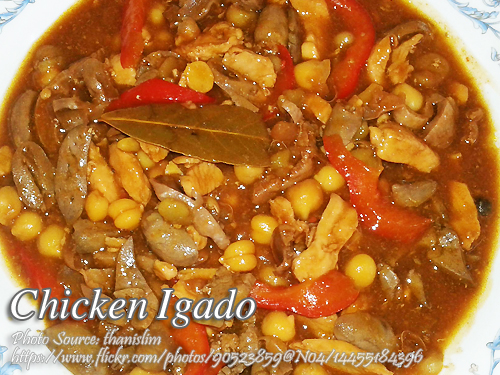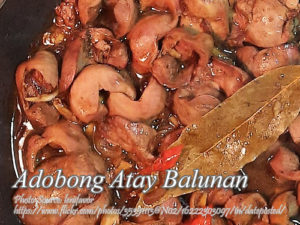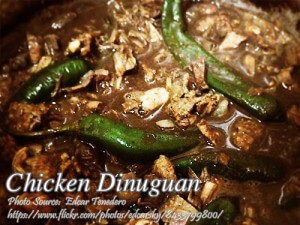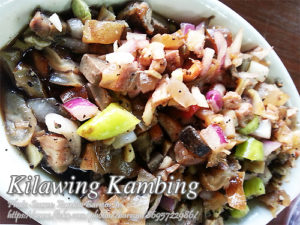The traditional Ilokano igado recipes main ingredient are pork liver, heart and kidney. This recipe, the chicken igado is a variation of the igado recipe which uses chicken internal organs like chicken liver and chicken gizzard. If you are in search for a healthier alternative of igado dish, I think this is what you are looking for.
Because chicken meat, compared to pork, have less cholesterol specially if you will use the breast part. The chicken liver and gizzards, when bought from a wet market contains lot of fats which you should discard before cooking. But most of the time, those sold in supermarkets are already trimmed and contains no chicken fat.
Chicken Igado: A Nostalgic Dish from the North
When my Tita Carmen would visit us from Ilocos Norte, she always brought with her a taste of home. The dish she most often prepared, one that never failed to transport us to our roots. This Ilokano specialty has a long history in our family, passed down through generations, and though it’s traditionally made with pork liver and other innards, she introduced me to a healthier twist: using chicken instead of pork. It’s one of those dishes that fills the air with the smell of garlic and onions, and for a moment, all the noise in the world seems to fade, replaced by the quiet hum of nostalgia and family.
Igado, at its core, is a savory, vinegar-based stew. While the original recipes often called for pork organs like liver, heart, and kidneys, my Tita Carmen, in her quest to keep things lighter and a bit healthier, swapped them for chicken liver and gizzard. This version is a testament to how traditional dishes can evolve while still keeping the essence of what makes them special.
The Heart of Chicken Igado: Livers and Gizzards
The magic of this chicken dish lies in the balance of flavors and textures. It’s a dish that plays with the richness of liver and the chewy, satisfying bite of gizzards. I remember the first time I watched my tita prepare it. She would always start by boiling the gizzards with lemon grass and ginger, a trick she learned from her own mother. It might seem unnecessary to some, but this step is key to removing any gamey odor from the gizzards and infusing them with a light, aromatic flavor. It’s these little steps that show the care put into every dish, something that you won’t learn just by following a recipe—it’s passed down through family wisdom.
As a beginner, you might find the idea of working with liver and gizzards intimidating, but don’t worry. Once they’re boiled and cut into strips, they become much more approachable. I’ve come to appreciate the earthy depth that chicken liver brings to the dish, while the gizzards provide a satisfying contrast in texture. Plus, compared to pork organs, chicken liver and gizzards are leaner, making this version a bit healthier, especially if you’re mindful of trimming any excess fat.
The Secret to That Rich, Golden Hue: Achuete Oil
One of the defining features of igado is its rich, reddish hue, which comes from achuete oil. Achuete, also known as annatto seeds, is a staple in Filipino cooking, lending dishes not just color but also a mild, slightly nutty flavor. I learned from my cousin Joel, who’s a budding chef, that the trick to making achuete oil without burning the seeds is to microwave them with oil for just a minute. It’s a simple but effective technique, and it makes a world of difference in adding that vibrant color to the dish.
Once the achuete oil is ready, sautéing garlic and onions releases an irresistible aroma that sets the stage for the chicken fillets to be browned to perfection. Sautéing in this oil ensures the meat absorbs the color and mild flavors of the annatto, giving the dish its signature look.
The Soul of Igado: Simmering and Seasoning
The essence of igado, like most Filipino stews, comes from simmering everything together. After stir-frying the chicken liver and gizzards, a bit of patience is needed to allow the ingredients to soften and the flavors to meld. It’s this slow cooking process that really brings out the best in the dish. I remember my Lolo Vicente always saying, “Good food takes time,” and he wasn’t wrong. The longer the chicken simmers with water and seasonings like laurel leaves and pepper, the more flavorful it becomes.
What makes this dish distinctly Ilokano is the use of vinegar. When the vinegar is added, it’s important to let it simmer uncovered for a few minutes. This step prevents the sourness from overwhelming the dish while also tenderizing the meat. Vinegar is a key ingredient in many Filipino dishes, and in igado, it provides that distinct tang that balances out the richness of the liver and gizzards.
Adding the Finishing Touches
Toward the end of cooking, chickpeas and bell peppers are added to the stew. These ingredients not only add color but also a subtle sweetness that rounds out the dish. My brother Paolo, who spent some time studying in Spain, once told me that chickpeas were likely influenced by the Spanish colonial era. It’s interesting to think how our food has been shaped by history, with different cultures leaving their mark on even the simplest of meals.
After a final simmer with a touch of fish sauce (or patis), the igadong manok is ready. Every bite is a taste of home—a blend of rich, tangy, and savory flavors that pairs perfectly with a steaming plate of rice.
A Dish Rooted in Tradition, Perfected Over Time
Chicken igado may have started as a humble dish, made with inexpensive cuts of meat and organs, but it’s one that has become a staple in many Ilokano homes. In our family, it’s not just a meal—it’s a tradition, a way of preserving the flavors and memories of the past while adapting to the present. Whether you’re a beginner looking to explore Filipino cuisine or simply in search of a new dish to add to your rotation, this chicken version of igado is a great place to start. It’s easy enough to prepare, yet rich with history and flavor.
I hope that when you make this dish, you’ll feel the same sense of warmth and connection that I do, and maybe even create your own family tradition around it.
How to Cook Chicken Igado (Igadong Manok)
Ingredients
- 1/2 kilo chicken fillet
- 1/2 kilo chicken liver
- 1/4 kilo chicken gizzard
- 1 pc bell pepper sliced into strips
- 1 Tbsp. achuete seeds
- 3 Tbsp. cooking oil
- 1/2 cup chickpeas or green peas
- 2 pcs laurel leaves
- 1 tsp. black pepper
- 1/4 cup vinegar
- 1 tsp. salt
- 1 pc chicken broth cube
- 3 cloves garlic crushed
- 1 pc medium size onion chopped
- 1 1/2 cup water
- 1 pc thumb size ginger slice into strips
- 1 stalk lemon grass pounded and sliced
Instructions
How to Cook Chicken Igado:
- Boil the chicken gizzard to remove the odor with lemon grass and ginger until tender. Then add chicken liver and boil for 5 minutes.
- Slice the chicken fillet into strips. Slice also the chicken liver and gizzards into strips.
- Make achuete oil by combining achuete seeds and oil and microwave for 1 minute.
- Heat achuete oil in a wok and saute the garlic, onion then the chicken fillet.
- Simmer for a few minutes until the liquid has evaporated. Then add the liver and gizzard and stir-fry for 3 minutes.
- Pour water and simmer again until the chicken meat, and gizzard is already tender.
- Add the pepper and laurel leaves. Allow the liquid to evaporate then pour the vinegar and broth cube.
- Simmer again for 3 minutes then add the chick peas and bell pepper.
- Simmer again for 3 minutes then add the salt or patis (fish sauce) and adjust or add a little more to suit your taste.
- Transfer in a serving plate and serve hot.
Video
Notes
Cooking Tips:
Properly Boil the Gizzards
Boiling chicken gizzards with lemon grass and ginger not only tenderizes them but also removes any strong, gamey odor. Make sure to boil them until they are tender to avoid a rubbery texture later in the dish. This technique enhances the flavor while making the gizzards more enjoyable to eat.Achieve the Perfect Color with Achuete Oil
To make vibrant achuete oil, combine achuete seeds and oil and microwave them for just a minute. This gentle method extracts the color without burning the seeds, giving your dish its signature golden-red hue. Remember to strain the seeds before using the oil for a smooth, rich color.Simmer the Vinegar Correctly
When adding vinegar to the dish, allow it to simmer uncovered for a few minutes before stirring. This step helps cook off the sharp, overpowering sourness and melds the flavors together more harmoniously. It ensures that the acidity balances the richness of the liver and gizzards perfectly.






susubukan ko yan chicken igado.sanay kasi kami sa pork igado.sure ko masarap yan.
Hi Monet, yes I’m sure okey itong chicken igado.